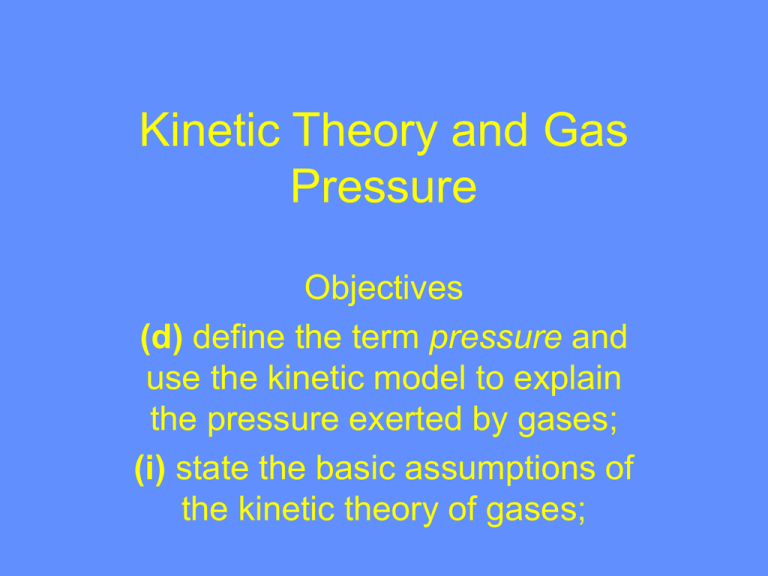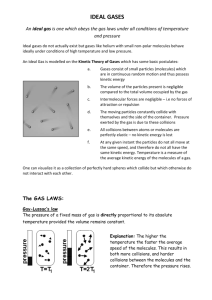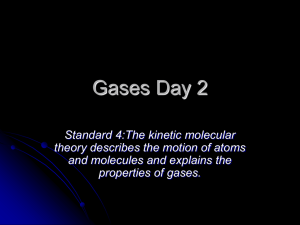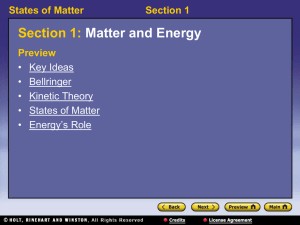The Kinetic Theory of Gases - science
advertisement

Kinetic Theory and Gas Pressure Objectives (d) define the term pressure and use the kinetic model to explain the pressure exerted by gases; (i) state the basic assumptions of the kinetic theory of gases; Outcomes ALL MUST Be able to define pressure. Be able to use the kinetic model to describe pressure. MOST SHOULD Be able to state the basic assumptions of the kinetic theory of gases. Be able to use the kinetic model to explain the pressure exerted by gases. Be able to select and use the equation p=1/3ρv2 SOME COULD Be able to derive the equation p=1/3ρv2 Pressure P (Pa) = F (N) / A (m2) Number of molecules Speed (c) cp the most probable speed c the mean speed (the average speed of all of the molecules) crms the rms speed ie the root mean square speed. A useful concept. Listen carefully and watch how it is calculated. The Kinetic Theory of Gases Question (We do not have enough particles here to be realistic but it will illustrate the point!) 6 particles have the following speeds: 600, 650, 650, 700, 725, 750ms-1. Determine the most probable speed cp, the mean speed and the root mean square speed crms. Thermodynamics The Kinetic Theory of Gases 6 particles have the following speeds: 600, 650, 650, 700, 725, 750ms-1. The most probable speed cp = 650ms-1 as there are more particles going at that speed than any other. Thermodynamics The Kinetic Theory of Gases 6 particles have the following speeds: 600, 650, 650, 700, 725, 750ms-1. The mean speedc = (600 + 650 + 650 + 700 + 725 + 750) / 6 = 679.16ms-1. Thermodynamics The Kinetic Theory of Gases 6 particles have the following speeds: 600, 650, 650, 700, 725, 750ms-1. The mean square speed 2 2 2 2 2 2 = (600 + 650 + 650 + 700 + 725 + 750 ) / 6 = 2,783,125 / 6 = 463854.17 The root mean square speed crms = 463,854.17 = 681.07ms-1 Thermodynamics Assumptions of the kinetic theory of an IDEAL GAS. 1 1 A Gas consists of particles called molecules. 2 2 The molecules are in constant random motion. As many travelling in one direction as any other. The centre of mass of the gas is at rest. 3 Intermolecular forces are negligible. 4 The duration of collisions between molecules is negligible. 5 Molecules move with constant velocity in between collisions. 6 6 The volume of gas molecules is negligible compared with the volume of the gas. 7 All collisions are totally elastic. 8 Newtonian mechanics can be applied to the collisions. The Kinetic Theory of Gases y l l m,cx If these assumptions are correct, we should be able to prove the equation of state for an ideal gas from these assumptions! WOW! l x z Thermodynamics y The Kinetic Theory of Gases l l Consider the change in momentum as the particle hits the wall m,cx l p = mcx - -mcx = 2mcx Time interval between collisions t = 2l/cx x z Now F=dp/dt from Newton’s second law so the force F of one molecule hitting the wall is given by: F=p/t = 2mcx / 2l/cx = mcx2 / l 2 (mcx 2 2 mcx 3 But p = F/A so p = / l) / l = /l If there are N of them then 3 2 2 2 2 p = (m / l ) (cx1 + cx2 + cx3 +...........+ cxN ) Note that (cx12 + 3 cx22 2 + cx32 +...........+ so p = (m / l ) Ncx = N(m/V)cx 2 cxN2) / N =cx 2 EQ(1) Thermodynamics y The Kinetic Theory of Gases 3 2 so p = (m / l ) Ncx = N(m/V)cx l l 2 EQ(1) m,cx l Pythagoras’ Theorem will show that c2 = cx2 + cy2 + cz2 - considering a general direction 2 2 2 2 and so c = cx + c y + cz 2 2 2 Due to the large no. of particles,cx =c y = cz x z 2 so c = 3 cx 2 from EQ(1) we get p So 1 Nm 2 c 3 V pV 1 2 Nmc 3 Thermodynamics Outcomes ALL MUST Be able to define pressure. Be able to use the kinetic model to describe pressure. MOST SHOULD Be able to state the basic assumptions of the kinetic theory of gases. Be able to use the kinetic model to explain the pressure exerted by gases. Be able to select and use the equation p=1/3ρv2 SOME COULD Be able to derive the equation p=1/3ρv2









